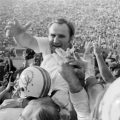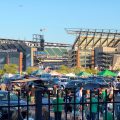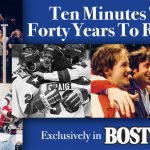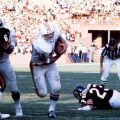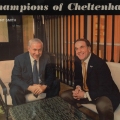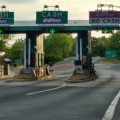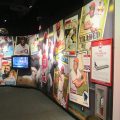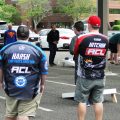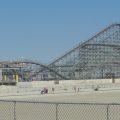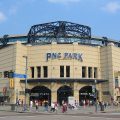Boston Red Sox
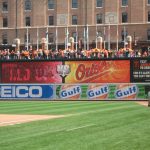
The Red Sox Fan’s Guide to Camden Yards
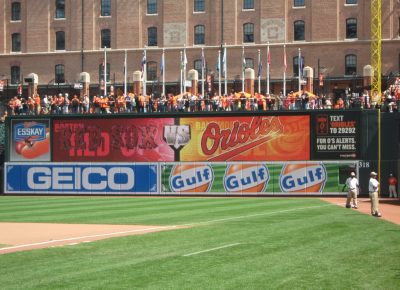
This article was published in the Spring 2019 issue of BostonMan magazine. Click here to read it on their website, or click here to see the PDF edition from the magazine itself. Hope you enjoy it.
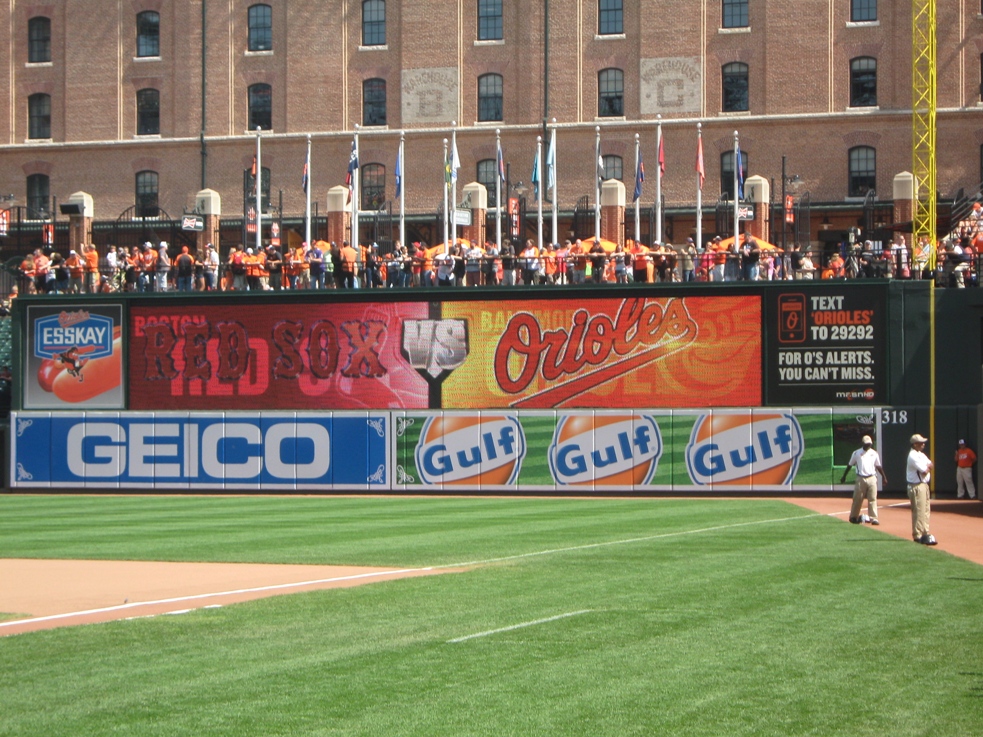
It’s not that the Boston nine haven’t enjoyed considerable glory since, but the last day of the 2011 season was a tough one to swallow.
On September 28 of that year, Oriole Park at Camden Yards showcased the climax of an epic Red Sox collapse. It was a season when the Sox were expected to run away with the AL East, steamroll through the playoffs and win their third World Series in eight years. When the dust cleared in Baltimore, a 7-20 September crumbling saw the team missing October and letting go of a manager who ranks among the biggest titans in Boston sports history.
Game 162 in 2011 may have been a delight for baseball fans just about everywhere else in the country, but it was momentously awful for Boston fans, most of whom had endured enough frowning from the Baseball Gods for one lifetime.
But if the last few paragraphs were tough for you to read, maybe you can take some comfort in the Baltimore faithful having something to cheer about, in what continues to be a nightmarish era for them.
The revolutionary home of baseball in Baltimore is currently…and probably will be for at least another three to four years…the oldest in major league baseball to have never hosted a World Series. This is, for forty-something and older Orioles fans, something impossible to have conceived in the days of Palmer, Robinson, Murray, the young Ripken, and master button-pusher Earl Weaver.
The younger Orioles fan base…true loyalists who cannot fathom the concept of their team being competitive every season…has understandable antipathy for Red Sox fans that often take over their ballpark, especially in lean years. That’s to say nothing of their exasperation at having to pay more for tickets for games against the Sox and Yankees.
So pull for the Red Sox like a good traveling fan. But at least let the locals know how great their ballpark is. They don’t have much else these days.
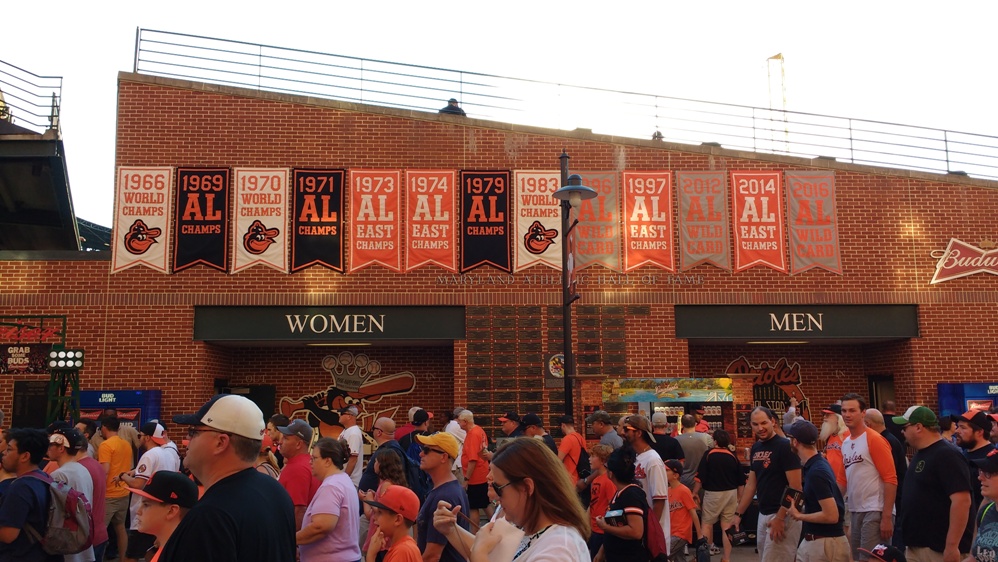
Yes, I keep telling people they were really good once.
Following a 115-loss season and a full commitment to a long overdue rebuild, the Birds aren’t likely to fill up Oriole Park very often in 2019. Not even for Red Sox games.
So now is the time to take advantage and visit a beautiful ballpark where you could experience some reverse sticker shock after years of attending games at Fenway. Even to see the Sox in a venue where you’ll be surrounded by your fellow Sox loving brethren, Camden Yards is a far less expensive outing…tickets for even the best seats will probably cost about a third of equivalent seats in Boston, great parking spots can be had for a double sawbuck or less, and even the food…well, okay, the food is still priced at a ballpark level. But you’ll have money left over for it after you park.
If you’re planning a weekend game in the summer months, it’s probably best to get your pasteboards in advance…not because they’re likely to sell out, but because you’ll have more choices. There will likely be a third party markup for weekend games, and the Orioles website allows you to actually pick individual seats. But during the week, try the box office at the north end of the B&O warehouse…you should still have plenty of seats to choose from, and you’ll save a chunk of change in online fees.
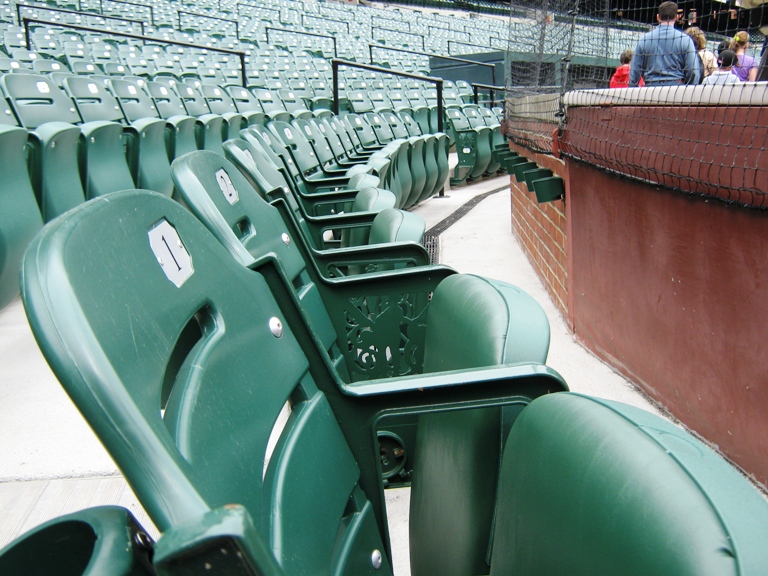
When your seat is half as comfortable as in the movie theater, you know you’ve made it.
Camden is one of those ballparks where fans say there aren’t any bad seats, which is true, but that doesn’t mean some aren’t better than others. If you’re splurging for those cushioned premium lower seats (and you should), the visitors’ dugout is on the third base side. As is the straight ahead view of the impressive warehouse, Oriole Park’s signature feature.
But while the lower concourse features great Baltimore-friendly eats like crab cakes, you’ll also be as far as possible from Eutaw Street. So if you go this route, show up early and get your Eutaw stroll in to see the plates commemorating home runs that landed there, including two from David Ortiz. It’s an essential in any Camden visit…along with your handshake and pit beef from Boog. Or your Rain Delay IPA at Dempsey’s, if you remember the former O’s catcher’s rain delay antics at Fenway.
If your budget is limited, upper level seats at Oriole Park work just fine. They’re closer to the field than in most ballparks, and are cheap even by baseball standards. (Bonus tip: the Orioles offer two free kids’ tickets with every adult ticket purchase.) You’ll have an outstanding panoramic view of both the field and the warehouse blending in with the Baltimore skyline, and the upper concourse features a fine view of the brick structure of downtown Baltimore in every direction, including M&T Bank Stadium (Ravens) across the street.
The Eutaw Street bleachers in center field…especially now that they’ve added a sit down bar there…are a popular spot for visiting fans too. But should you catch an Orioles home run ball, don’t throw it back. That happened in a game in 2011. I’m not saying the Baseball Gods punished the Sox for that behavior, but I’m not saying they didn’t either.
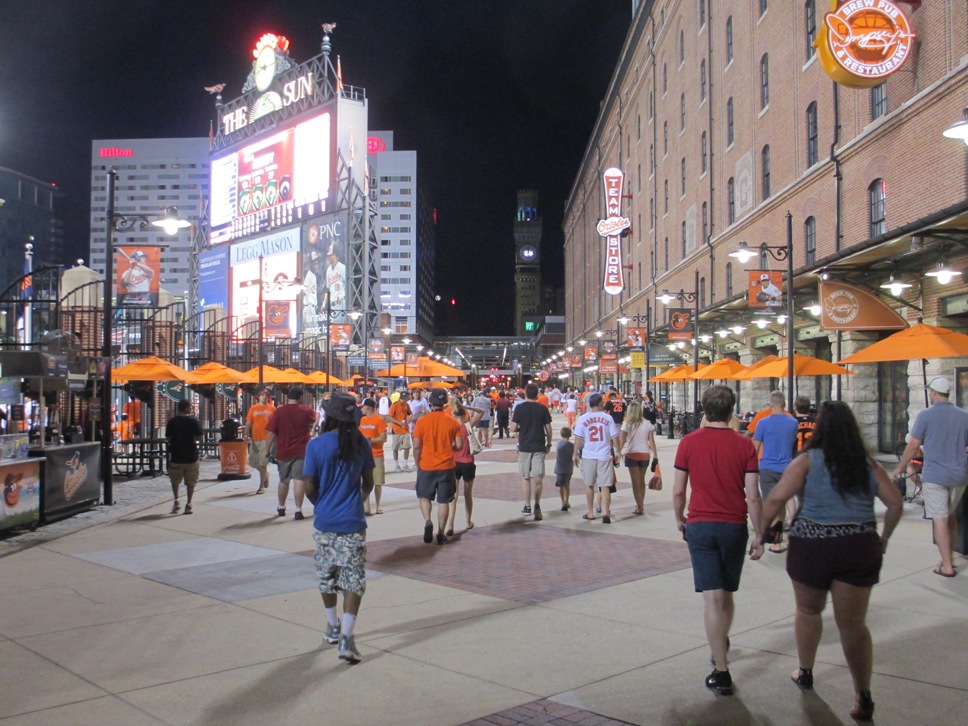
The Eutaw Street view of the Hilton.
With Baltimore being 400 miles from Boston, you’ll probably be spending at least one night in town. There are plenty of upscale hotels in downtown Baltimore, including the impressive Hilton across the street from the Yard. Just know that unless you’re staying at the Hilton or another hotel just a few footsteps away, you might not be comfortable walking to the ballpark, especially at night.
This is probably of no nevermind, since you have a plethora of parking options for Orioles games, from Orioles’ lots east of the ballpark to surrounding garages downtown. None of the lots and garages in Baltimore are gouging in price the way you’re used to at Fenway, but you will likely find a better deal near M&T Bank Stadium, especially if you don’t mind walking a bit. Parking east of the ballpark also makes for a much easier in and out.
If you’re not staying downtown, you also have the inexpensive and convenient Light Rail option…park for free along the route, and take the streetcar right to the entrance of the ballpark. It’s not just a good deal cheaper, it spares you the considerable headache of driving in downtown Baltimore, where red light duration can be measured in eons and could even cost you an inning of baseball. You can also take the Light Rail directly from Penn Station, should you be using Amtrak.
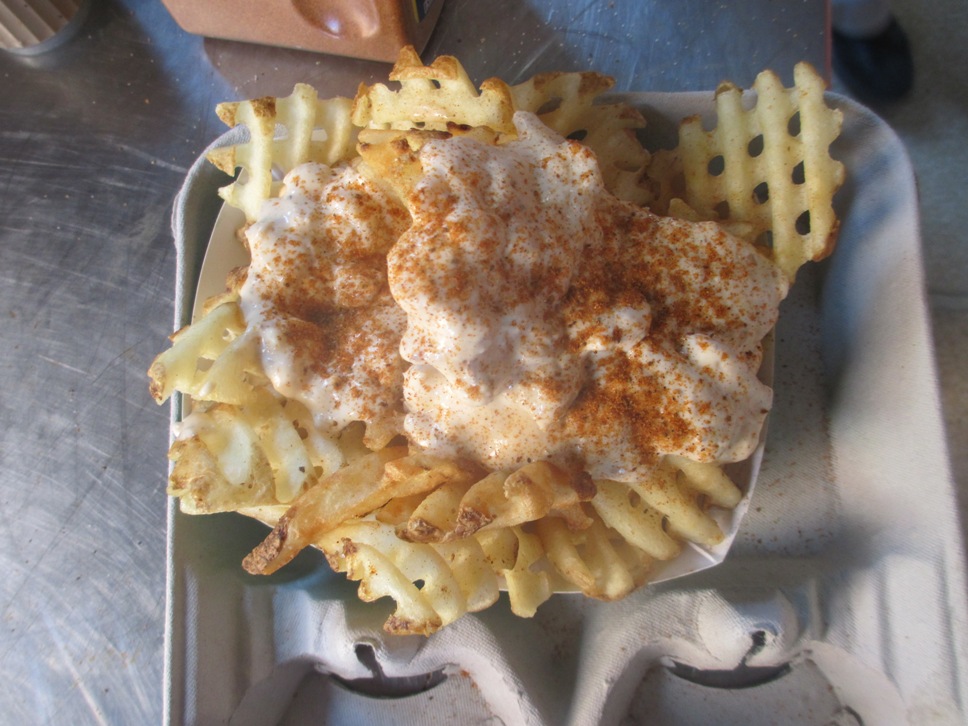
This is what makes Baltimore baseball great.
Fenway Park features lobster poutine, lobster rolls, and lobster melts. Oriole Park has crab cakes, crab kettle chips, and crab waffle fries. Not a big adjustment for Massachusetts natives.
Yes, people rave about Boog’s BBQ here and rightly so. Just know that Boog’s amazing pit beef and turkey sandwiches aren’t your only option. In the lower level concourse, you can find a baseball-sized crab cake (the Orioles tried about 50 recipes before hitting on the right one for it), kettle chips with crab meat piled on, or crab dip waffle fries that are worth grabbing a fork and sitting down to eat. And pile on some Old Bay at the condiment stands.
It’s all great for a taste of Maryland, but don’t forget about the eats and libations outside the ballpark too, especially across Washington Boulevard from the Left Field Gate. The pre-game watering hole tandem of Pickles Pub, Slider’s and the Bullpen all offer dogs, sausages, burgers, and yes, crab cake sandwiches at prices much cheaper than inside. You can wrap this stuff and bring it in, incidentally. And like inside the ballpark, there will be enough Red Sox fans at the pre-game party that have your back. (Not that O’s fans will give you any trouble.)
Speaking of libations…the establishments across the street continue to offer a brew that the Orioles amazingly do not sell inside the ballpark…National Bohemian, affectionately known as Natty Boh. How vital is the one-eyed Natty Boh logo to the Baltimore baseball experience? When this team was consistently good (yes, they really were once), it was the brand sold at Memorial Stadium…because the owner of the team happened to be the owner of National Bohemian.
You’d think the Orioles would respect that. Maybe someday. But for now get your Natty Boh on across the street and salute the…wait for it…“once proud Orioles franchise”.
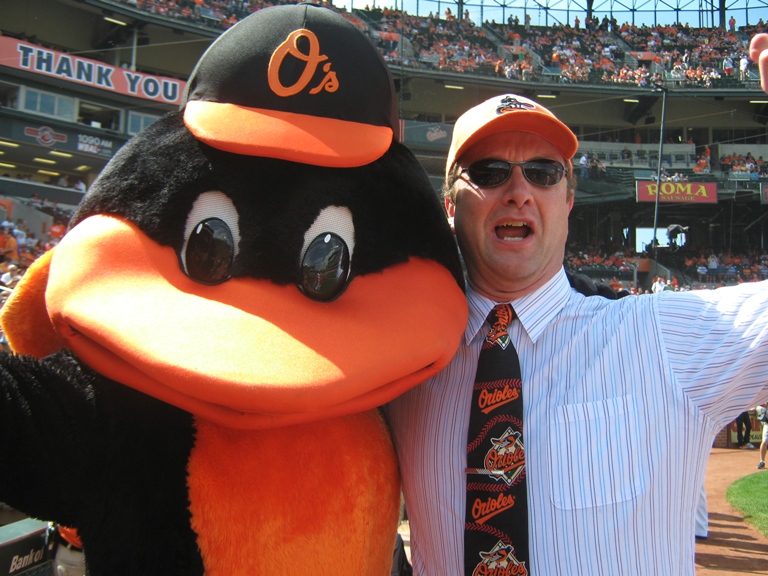
The Birds’ two biggest fans.
One of the multitude of features the designers of Camden Yards got right was its location…in the heart of downtown Baltimore, just steps away from the beautiful Inner Harbor. Out of town visitors can enjoy a ballgame, a delightful pre- or post-game meal, and visit the top tourist attraction in the city in one day.
If you haven’t yet crossed a Red Sox game at Oriole Park off your bucket list, 2019 is the year to do it.
A Name You Should Know
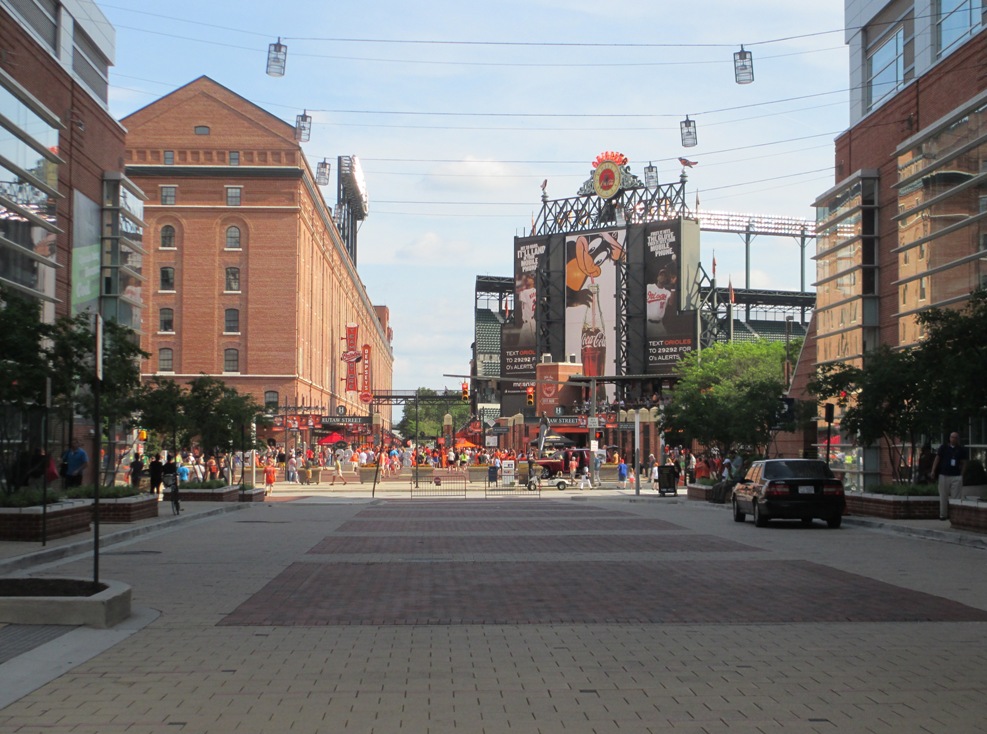
It’s the warehouse. Chicks dig the warehouse.
On the website “This Great Game: The Online Book of Baseball History”, former commissioner Bud Selig is quoted as saying that Baltimore’s revolutionary ballpark “may be one of the two or three most powerful events in baseball history. It changed everything. It really did. I’m not sure people grasp the significance of it.”
Selig is probably correct. Yet it’s doubtful that it would have been the case without the prominence of the B&O Warehouse, however impressive a new ballpark otherwise might have been. The Warehouse gave Camden Yards a striking, standout visual element that was comparable to Fenway’s Green Monster. It made a great venue into a phenomenal one.
Yet the man arguably most responsible for its preservation never received any official credit.
Eric Moss was an architecture student at Syracuse University who spent a year developing a model for Baltimore’s ballpark that included the long, bulky, old brick structure…his design even featured the Warehouse as part of the playing field, suggesting that the Orioles would have to budget for window repairs.
His design was seen by one of the firms competing for the Oriole Park contract, Ayers Saint Gross. The firm actually brought Moss and his design to Baltimore. At the time, the warehouse was set to be demolished, an idea that had the backing of even the Orioles. Moss’s design showed how the building could not only be preserved, but also be an integral component of the ballpark itself.
Moss’s idea to build the ballpark around the warehouse survived…but Ayers Saint Gross lost the contract bid to HOK Sport, who ultimately designed not just Camden Yards, but dozens more sports venues in the wake of Camden’s success.
Eric Moss’s name is not on any of the official design documents. But he landed a nice career out of it. He is still today an architect at Ayers Saint Gross.
One Year To The Day
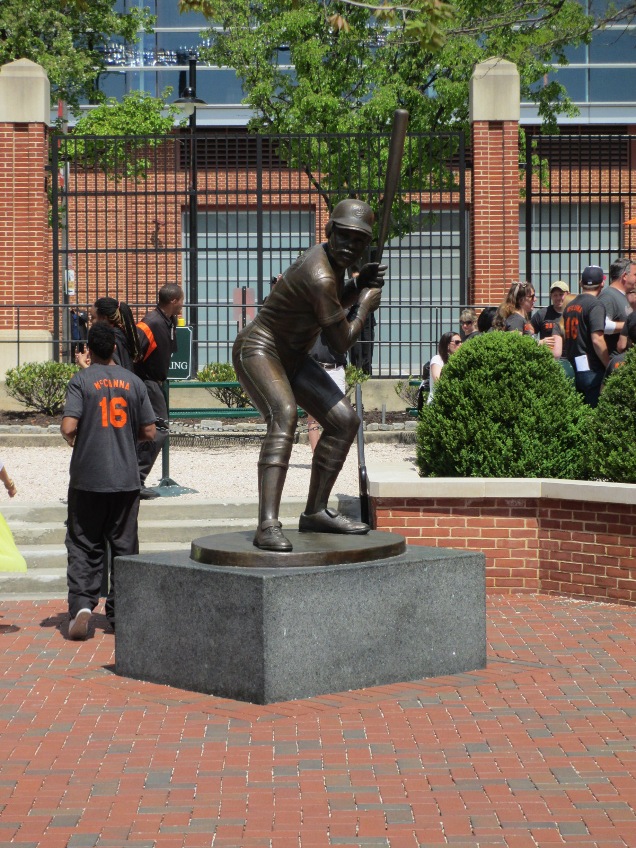
Damn, this guy could hit.
Every baseball fan remembers what happened at Camden Yards on September 6, 1995. Cal Ripken Jr. took the field for the 2,131st consecutive time, and single-handedly restored a country’s love for a sport that had been badly damaged by its participants’ greed. As the ballpark’s history goes, it’s not likely that anything short of an Orioles World Series victory could top the moment.
One year to the day later, longtime Orioles star Eddie Murray made September 6 extra special for Orioles fans, launching a home run into the center field seats following a rain delay that caused the early exit of several thousand fans. This wasn’t just any home run, by the way…it was number 500 of Murray’s storied career. He would finish with 504.
Murray and Ripken were arguably the two key members of the last Orioles team to reach the top of the baseball mountain. Both of them were relatively young stars in 1983, the year the Orioles took the crown against the Phillies. The two teammates and friends battled for the MVP all season, with Ripken taking the honors and Murray finishing a very strong second. (Carlton Fisk finished a distant third.) Neither would play for a World Series winner again in their careers.
Ripken credited Murray as one of the reasons he played in every single game for over 16 years. It was Murray, he said, that stressed to a young Ripken the importance of always being ready to play.
Today both players have statues and retired numbers 8 and 33 at Camden Yards, immortalizing their careers with the Birds…and the seat where Murray’s 500th home run landed is now painted orange to commemorate the occasion.
The Peanut Church

Peanut bags – keeping churches maintained since 1992.
(photo courtesy of the Old Otterbein United Methodist Church)
As stated in this article, you can bring food and non-alcoholic drinks into Camden Yards. This lenient policy of the Orioles has been a great boon to nearby people of faith.
The Old Otterbein United Methodist Church, located near Conway Street adjacent to the ballpark, discovered in the early days of the new ballpark that Orioles fans would be happy to pay a dollar for a bag of peanuts rather than quadruple that price inside.
They’ve been selling peanuts to fans heading to Orioles games since the ballpark opened in 1992…and they’ve used the proceeds from peanuts and water sales to restore an organ, replace the roof, fix crumbling brick walls and repair the electrical and HVAC systems.
According to the church’s website, “The best sales are always when the ‘Yanks’ and ‘Red Sox’ are in town.” So when you buy peanuts from the Old Otterbein, you’re not only saving money on everyone’s favorite ballpark snack, you’re helping a local house of worship maintain their home.
So there are some Baltimore natives that always will be happy to see you, even if you’re wearing Red Sox gear.
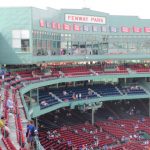
Fenway Park vs. Wrigley Field – Two Ballpark Aficionados Debate
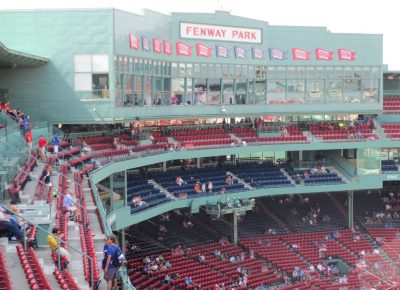
Stadium Journey published the much-anticipated debate between me and Joe Mock – and our locking horns over which of America’s two oldest ballparks is a better place to see a ballgame. I thought we put it together well. Hope you enjoy the read. (Click here to see the PDF from the magazine; click here to visit the excellent Stadium Journey website.)

In this corner, the Green Monster American Leaguer from Boston!
BALLPARK VERSUS BALLPARK
Fenway or Wrigley – Which is the best?
Joe Mock (www.BaseballParks.com) and Kurt Smith (www.BallparkEGuides.com) are webmasters for two of the most popular ballpark-themed websites on the net…and both are foremost authorities on what makes Wrigley Field and Fenway Park special. But which ballpark takes the top spot in the battle of the two classics?
The two disagree on the answer, with Joe preferring Wrigley and Kurt siding with Fenway. Let the debate begin!
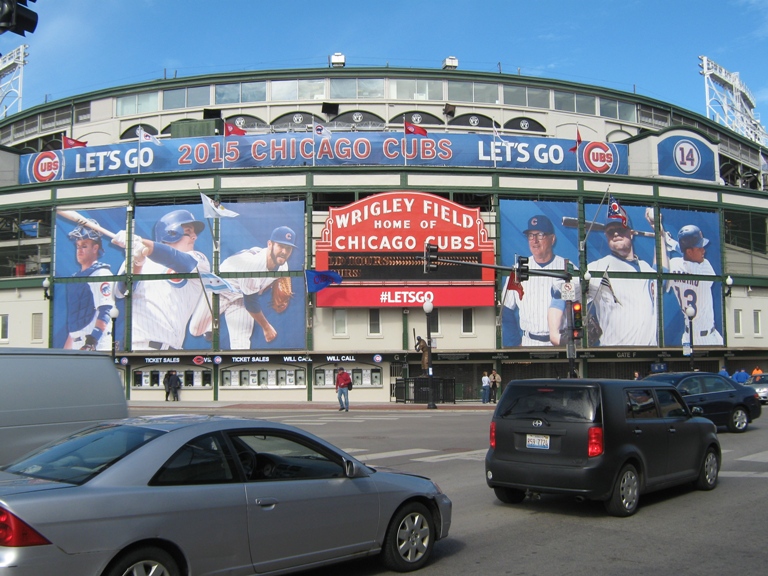
And in this corner, the ivy-covered National Leaguer from Chicago!
Each Ballpark’s Place In History
JOE: When you have two parks that date back over a century, that’s a LOT of history. Wrigley, though, wins in this category, but not by a lot.
Simply standing within the Friendly Confines fills you with a sense of history that can’t be matched by any other facility – of any sport. One reason for this is because of the way the park looks. The stately stands. The bleachers. The ivy. Just everything.
In 2014, I got to cover the 100th birthday of Wrigley for USA Today, and the way the Cubs put on the event showcased that history. While wearing throwback uniforms, they played as the Chicago Whales of the 1914 Federal League. You had no trouble envisioning the Whales playing in that ballpark. And to give the proceedings an extra air of century-long authenticity, the home team blew a lead and lost the game.
From the legendary called shot by Babe Ruth to the tragedy of Steve Bartman to the mind-blowing prowess of Jake Arrieta, Wrigley is history.
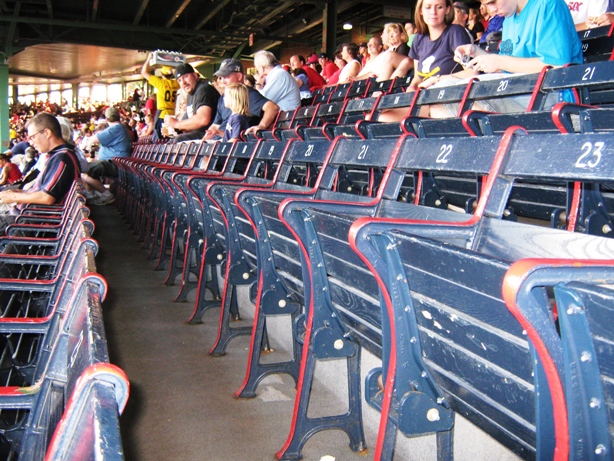
Nothing says “old ballpark” like small, wooden grandstand seats.
KURT: I agree with Joe that both Fenway and Wrigley can’t help but feature history as the backbone of their greatness…Babe Ruth (supposedly) called his shot at Wrigley and pitched at Fenway…but I disagree on the key point Joe makes about the ballparks’ look, at least now.
The Red Sox and Cubs have both recently renovated their classic ball yards, but the Red Sox enhanced the historic aspects of their ballpark, while the Cubs disrupted it. The Red Sox placed seats atop of the Green Monster and closed off Yawkey Way during games to create a great pre-game atmosphere, and the new video boards in Fenway actually look like the hand-operated classic in left field and blend in very nicely.
By contrast, the Cubs placed a huge, high-definition video board in left field that is anything but historic…and many fans agree looks completely out of place. In doing so the Cubs not only blocked the view from the Waveland Avenue rooftops, but also made the hand operated out-of-town scoreboard in center field look completely unnecessary. The rooftops and scoreboard, to these eyes anyway, were as iconic as the ivy. Maybe they had to install the video board, but it’s impossible for me to believe it couldn’t have been done better.
Before both parks were renovated, I might have given the history nod to Wrigley, but the Red Sox seemed to have much more of an eye for the ballpark’s history in their renovations.
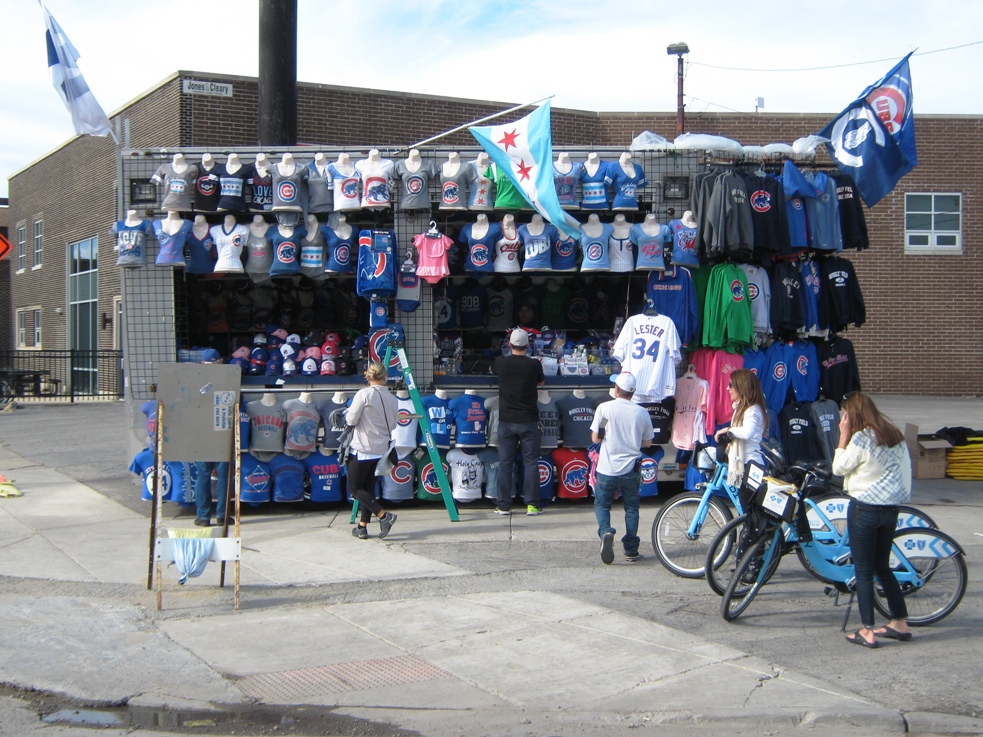
It’s not a real ballpark unless you can haggle for a cheap tee.
Surroundings
JOE: While I like the street fair atmosphere of Yawkey Way before a Sox game, you have to admit that it’s somewhat contrived. A street that is normally open to traffic is shut down for a few hours when there’s a baseball game. That’s the opposite of being “organic.”
Wrigleyville, though, is Wrigleyville 365 days a year. From the bars across the street (I mean, everyone knows the Cubby Bear, right?) to the Addison station of the red line of the L train to the neighborhood businesses and tenements that come right up to the ballpark’s footprint, nothing compares.
And does Fenway have anything like the rooftops across Sheffield and Waveland? Hardly.
No, just mentioning the “corner of Clark and Addison” evokes images of the one-of-a-kind neighborhood that surrounds Wrigley.
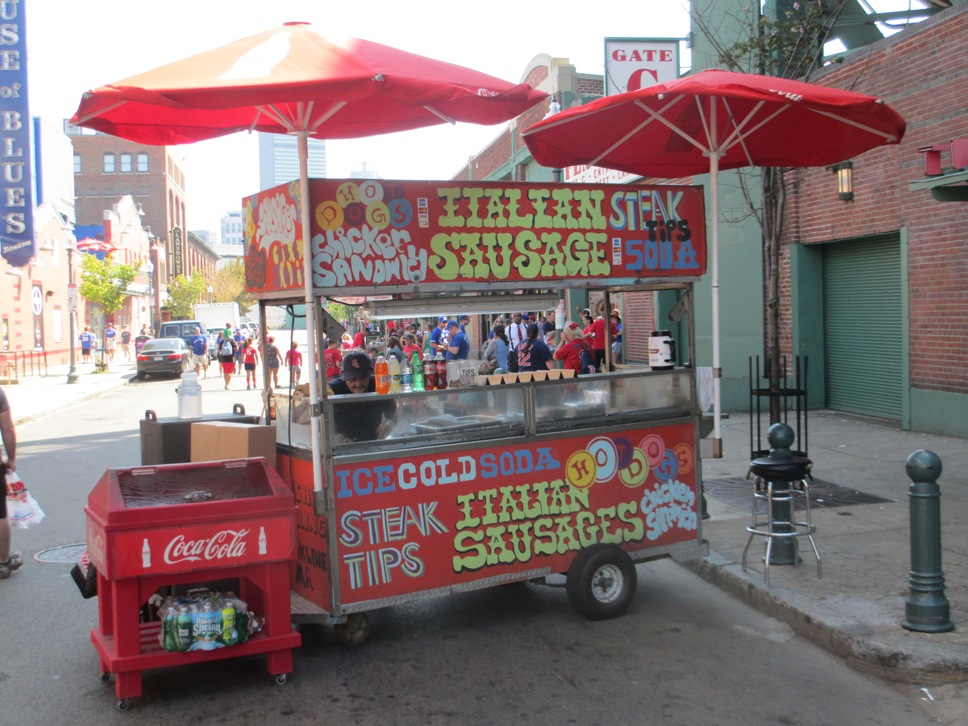
The iconic Fenway encased meat stand.
KURT: Again, Joe is right about Wrigleyville and the entire neighborhood being part of a Cubs game celebration…but unfortunately, the Cubs are disrupting that too, with their plans for a high end “plaza”.
Fenway has one very special surroundings element that Wrigley doesn’t…sausages. Lansdowne Street alone has almost a dozen purveyors of pregame sausages, dogs, chicken teriyaki or steak tip sandwiches…each one unique and many with their own brand of hot sauce.
Fenway also is right there with Wrigley in your choices of pre- or post-game party…play ping-pong at Game On, have a Bunker Hill Blueberry Ale at Boston Beer Works, or get some very cheap eats at the Baseball Tavern. Or even watch the game for free from the Bleacher Bar for a few innings. There’s something for everyone.
And while Yawkey Way may be contrived to be similar to Eutaw Street in Baltimore, it’s not a bad idea…I wouldn’t mind the Cubs turning Sheffield Avenue into part of Wrigley during games.
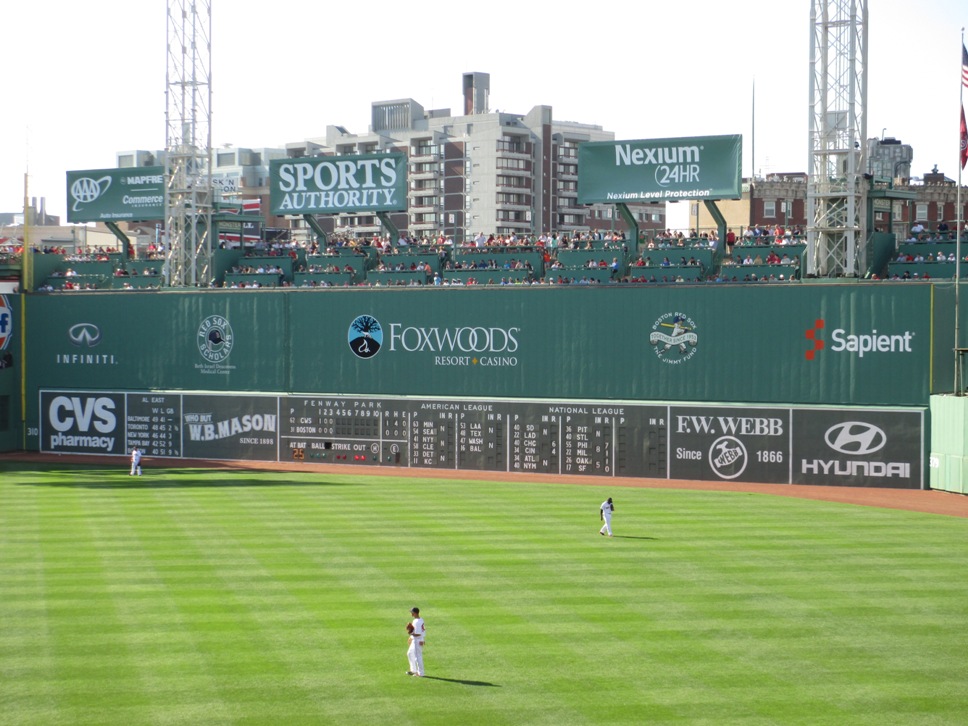
Because we couldn’t build it out onto Lansdowne Street.
Architecture
KURT: The Green Monster says it all…this ballpark is not only built on one city block, but that block is shaped such that if we put a normal fence in left field, bloops just barely out of the infield could become home runs.
The big wall in left field is the centerpiece of a design so asymmetrical that a team would be accused of ridiculous contrivance of dimensions if they tried it today. Fenway Park almost looks stretched sideways looking at it from overhead.
I’ll never argue that Wrigley has a million unique things about it, but its dimensions aren’t one of them. It was built on one city block too, but the block is square and as such the dimensions don’t give a hitter an advantage on either side of home plate.
Only in Boston could a ballpark be shaped like Fenway…it makes the ballpark one of the more architectural wonders in a city with quite a few of them.
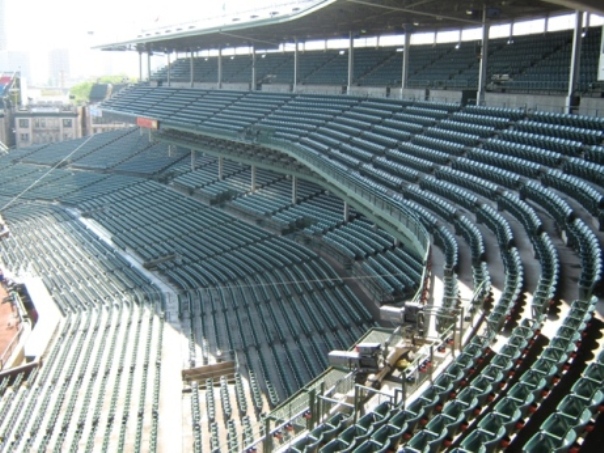
Just build the ballpark in the right spot, and then everyone can see!
JOE: Kurt, it’s interesting that you bring up both Fenway’s shape and its dimensions, because I believe both are drawbacks.
Regarding the shape of Fenway’s footprint, I would term it “misshapen” more than “stretched sideways.” Like a lot of parks built during the concrete-and-steel era in the first couple of decades of the 20th Century, Fenway’s design evolved over time (but was always limited by the non-square parcel of land).
But this evolution has created a truly undesirable arrangement of seating in Fenway, where a ridiculously large percentage of seats are beyond right center field and, worse, in the right-field corner beyond the foul pole. If you’ve tried to watch a game from a seat in that corner, you’ll know what I mean.
Wrigley, though, evolved in an orderly way that the original architect, Zachary Taylor Davis, could’ve easily envisioned. Hence you have a true upper deck with fantastic views of the field – even from its farthest reaches – and outfield seating that makes sense.
Regarding the dimensions of the two fields, I would again apply the word “misshapen” to Fenway. With foul poles that are 302 feet away in right and, we assume (since the Red Sox discourage anyone from actually measuring it), 310 feet in left, and the silly “triangle” near center, it makes for bizarre dimensions. While I like some originality in outfield dimensions (like the two “wells” in Wrigley’s outfield), the number of oddities in Boston outfield are far too numerous.
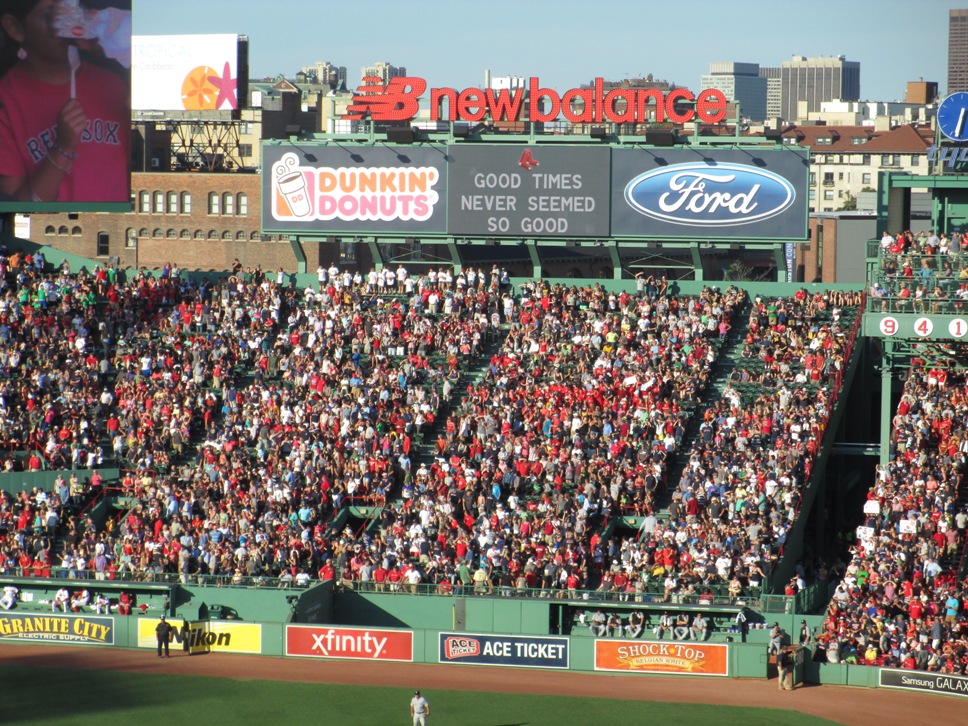
With helpful lyrics on the scoreboard for the two fans that don’t know the words.
Gameday Atmosphere
KURT: When the Red Sox expanded the ballpark, so to speak, into Yawkey Way (now Jersey Street), they created a wonderful pre-game atmosphere for kids of all ages. The old-time band playing, Big League Brian on his stilts, carts selling roasted peanuts and Luis Tiant selling Cuban sandwiches…that’s baseball at its best.
Red Sox and Cubs fans both deserve props for their dedication, and both teams’ fans are raucous and show up in large numbers. But while I’m not knocking anyone’s reason to come to a ballgame, there are fans at Wrigley that are there more for the party than to cheer the Cubs. It’s not just me saying that…I’ve read that a lot. Red Sox fans are rarely accused of this. Everyone in the ballpark lives to hear “Dirty Water” blaring on the PA after a Red Sox victory.
Not to harp on the renovation point again, but the Cubs also did some damage to the gameday atmosphere with the video board and strong arming of businesses like street guys selling programs. The Bucket Bangers, for example, are essential Wrigley…I don’t know if the Cubs were responsible, but I didn’t see or hear them in my last visit. And I missed them.
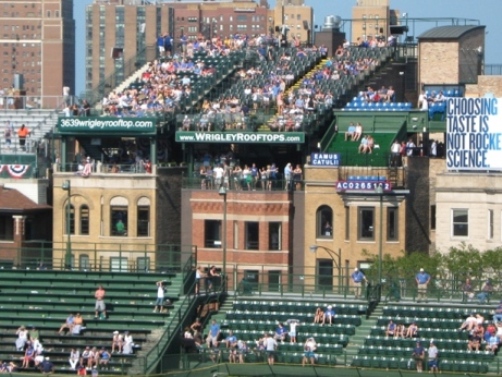
Where else do houses across the street have grandstands?
JOE: While I concede that the Cubs’ current owners made a number of changes based on business decisions rather than aesthetics, it’s still a blast attending a Cubs game. Without the need for the contrived closed-off-street of Yawkey Way, the area around Wrigley is truly alive before and after games.
And there’s something endearing about fans who for generations have come to the Friendly Confines more for the park and the experience than to root for the perpetually losing team. And you can’t say it’s not an “experience” to go to a Cubs home game, win or lose. The front office makes sure of that. The entire season of Wrigley’s 100th Birthday in 2014 was a testament to that.

The Fenway Frank. Essential ballgame sustenance.
Concessions
KURT: Both Wrigley and Fenway are relatively simple in their concessions, at least compared to places like Nationals Park (shawarma) and Progressive Field (Froot loop dogs). When it comes to the basic ballpark food…the basic hot dog…Wrigley doesn’t have the uniqueness of the Fenway Frank. Mushy white bread buns are part of baseball.
Actually, one could argue that there’s a better variety at Wrigley, and there is, at least inside both ballparks. Wrigley does have Gilbert’s sausages and Hot Doug’s dogs, and Giordano’s deep dish pizza is better than Papa Gino’s. But when you add the outside sausage vendors, Fenway has a definite edge…the Inner Beauty hot sauce at the Sausage Connection and the plain sausage and peppers from the Sausage Guy are without peer even inside of Fenway.
Plus Fenway has lobster rolls, so Wrigley featuring Italian beef doesn’t weigh in favor of Wrigley as much…
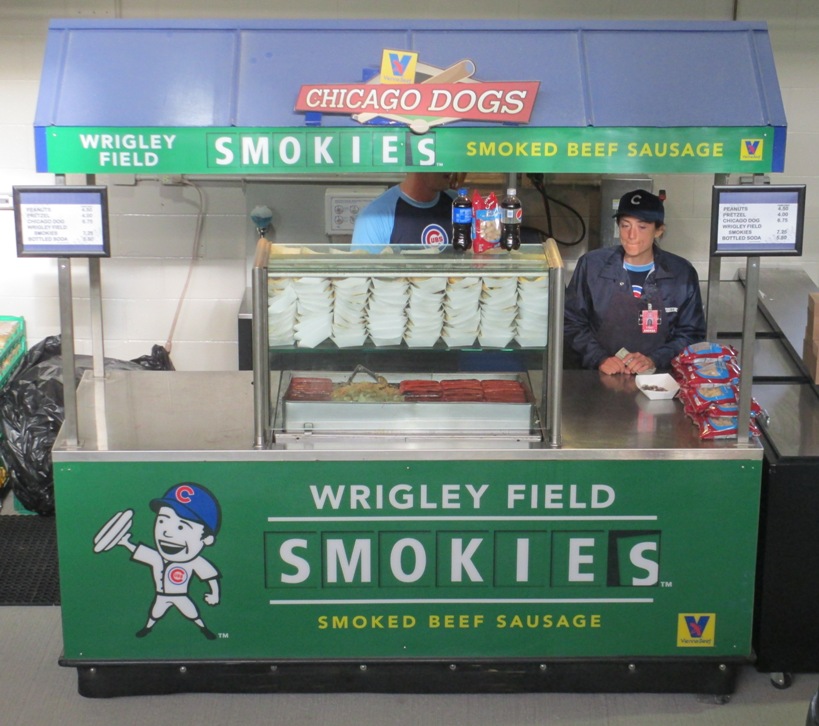
Joe’s got a point about the variety of hot dogs and sausages.
JOE: I’ve always felt the concessions at Fenway were fine, but never in the top ten in the Majors. If you insist, Kurt, on including food sold outside of the ballpark, that does elevate Fenway’s food ranking, but not by much.
I agree that the Giordano’s pizza at Wrigley is better than what’s in Boston, but I think the difference isn’t slight. I think it’s huge. Giordano’s is that good.
The sausages and franks at Wrigley speak for themselves, and far outpace anything of the sort at Fenway. New this year are variations on chicken sausage by Gilbert’s.
And since you’re including food found outside Fenway, I’ll do the same with Wrigley. In the Wrigleyville area, you’ll find perhaps the best corned beef sandwich anywhere at DMK Burger Bar, and next door at the Fish Bar there’ a zesty po-boy that includes both shrimp and crawfish, and a wonderful lobster roll (!). And at Giordano’s sit-down eatery, you can experience their entire array of scrumptious pizzas of varying crust thicknesses, and a savory chicken parm.
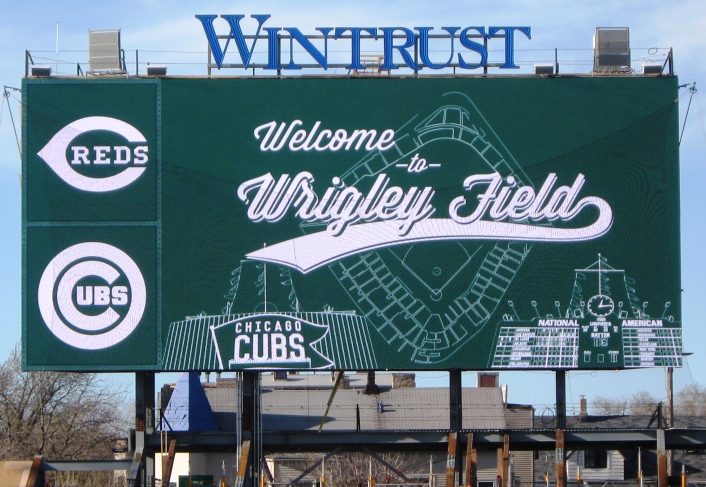
Just the words invoke a happy feeling.
Summary
JOE: In 2013, USA TODAY asked me to write an article about each MLB park. They then ran one article per week in their Sports Weekly publication, doing a countdown from number 30 to 1. My top park was Wrigley. I supported that ranking by pointing out the wonderful gameday environment there and the stupendous sense of history.
There’s no doubt that both Fenway and Wrigley are national treasures, and are among America’s most beloved parks – probably the top two on that list. Wrigley, though, edges out Fenway, especially when you consider architecture, surroundings and concessions.
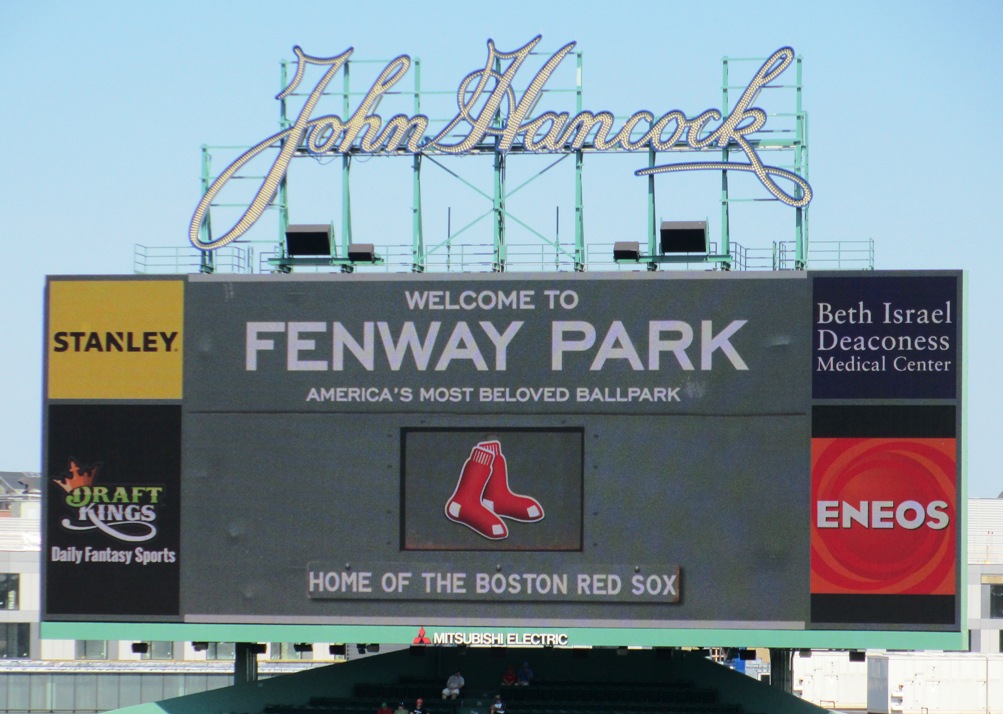
Ditto.
KURT: In the pre-renovation years of both ballparks, I had actually preferred Wrigley to Fenway, largely because there were a lot of pitfalls to mar the experience at Fenway…small concourse space, parking difficulties, and lots of not so great seats. Now that I have researched both ballparks thoroughly, I’ve come to realize that the challenges of Fenway are what makes it great…it’s not a ballpark for amateurs, and it brings out the best in fans.
Wrigley is still a fantastic, iconic venue and as Joe says, a Cubs game is still a blast. It’s just going to take some time for me to get used to the gigantic video boards…and the loss of the rooftops and many of the nearby vendors. There is a stark contrast to how both teams handled their renovations, and it what makes Fenway superior these days, in my totally humble opinion.
Enjoy this article? Check out more about ballparks from Joe and Kurt!
Joe Mock is the writer and photographer for BaseballParks.com, which dates back to the dawn of the Web in 1997. He also writes regularly for USA TODAY Sports. Kurt Smith is the owner and author of Ballpark E-Guides, the highly acclaimed (even by Joe Mock!) detailed fan’s guides to 15 major league ballparks, including Wrigley and Fenway. He is also a staff writer for JerseyMan and BostonMan Magazines.
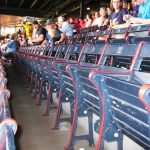
The Hard Is What Makes It Great – Fenway Park

It was a great privilege to contribute this piece about one of my favorite ballparks to the debut issue of BostonMan Magazine, which was released in the fall of 2018. You can read the article on BostonMan’s website, or click here to see the PDF from the magazine.
It wasn’t easy to conceive an angle about Fenway that would be new to Boston sports fans, but every Red Sox fan that read it loved it, which made me very happy. I hope you enjoy it.

Baseball As It Is Meant To Be Watched.
“The Hard Is What Makes It Great.”
The venerable home of the Red Sox has survived not only a relentless ballpark boom, but a new wave of disregard even for relatively new venues. There’s a reason for it that few people outside of Boston understand.
By the time you read this, there may be another World Series about to take place in the ballpark that has sat in Beantown for over a century. The Red Sox have, after all, shown a palpable disregard for supposed curses in the last decade and a half.
When you think about it, it’s no small miracle that Fenway Park is still standing. Lately, you don’t even have to think about it all that much. As ballpark architecture changes at a dizzying rate, Fenway insistently puts its foot down, asserting its unassailable right to continue hosting the world’s greatest game. It remains the immovable object that triumphs over the irresistible force.
Over the last three decades, as municipalities and teams realized there were billions to be made in corporate suites, some romantic and profoundly historic temples of baseball met with the wrecking ball. Most distressingly, even Tiger Stadium, old Yankee Stadium and Comiskey Park were unceremoniously felled by baseball economics. It’s hard to imagine it now, but there indeed was a time when Fenway was in the crosshairs too…and the idea of replacing it had plenty of support.
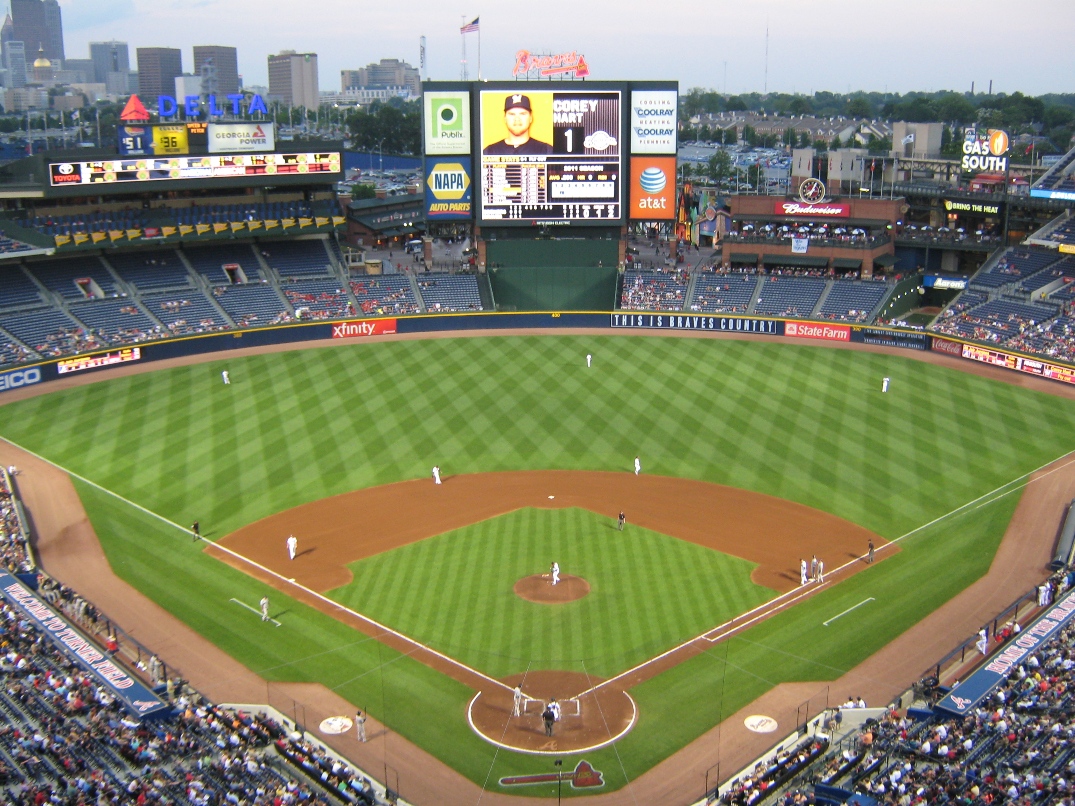
Turner Field in Atlanta. Great ballpark, but you didn’t have long to knock it off your list.
In recent years, the discarding of venues considered shiny by Fenway standards makes it even more remarkable that the ballpark continues to defy its demolition. Teams are now departing from delightful and appealing baseball homes that most fans remember opening. Turner Field in Atlanta lasted just 20 seasons as the home of the Braves, magnificent Globe Life Park in Arlington will be replaced in 2020 after just 26 seasons, and the Diamondbacks have begun the process of exiting Chase Field in Phoenix, another ballpark just 20 seasons old.
Think about that. The Metrodome outlived these outstanding ballparks.
The sports venue boom, one could easily argue, is now completely out of control. For absurd reasons, at least the publicly stated ones, teams are tossing aside perfectly nice baseball settings. The Braves actually cited “traffic” as a problem with Turner Field, as if it’s somehow possible to smoothly shoehorn 20,000 cars into any parking lot on earth in the space of a couple of hours. (Spoiler alert: the traffic at SunTrust Park is far worse. At least Turner Field had a viable public transit option.)
It’s not all that difficult anymore to conceive that Oriole Park at Camden Yards, the venue that started all of this, could itself be threatened with extinction in the not too distant future. As perfect for baseball as Camden is, the Orioles can’t even give away tickets these days…and they’re literally doing just that.

Sure, they haven’t been in the Series since the Reagan Administration. But they revolutionized ballparks at least.
The stunning ballpark creations that arose in response to the phenomenal success of the architectural wonder in Baltimore have been warmly received by spectators. This is especially true in places like Philadelphia, where fans sat in a concrete donut designed for football for 33 seasons. Citizens Bank Park is, by any fathomable measure, a superior venue to Veterans Stadium.
Many of the new ballparks were designed with the charm, or more correctly, the “old time features” of places like Fenway, like neighborhood-necessitated dimensions and distinctive visual landmarks…but without the small seats, grossly insufficient leg room (did people really top out at five-foot-four in 1912?), obstructed views, and fuming in 3 MPH traffic to find exorbitantly priced parking.
With all due respect to Camden Yards, which truly was executed flawlessly, the modern amenities babble is exactly where all of the new venues miss the point.
The home of the Red Sox was never meant to be a place where millennials gather for craft beer tasting, or where patrons sample gourmet sushi from an executive chef, or where fans loudly cheer a mascot race. It’s not that Fenway doesn’t have extras geared to folks that are less than fanatical about baseball. It does. But they’re not emphasized here. There is nowhere near the outreach to “casual fans” at Fenway like there is in nearly every other ballpark in America.
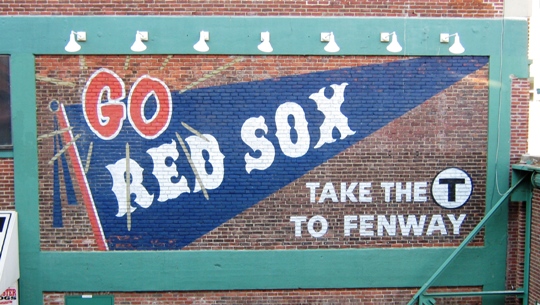
Yes, believe it or not, that packed to the gills train you were just on is the easiest way to get here.
Fenway Park is difficult. It’s the most challenging ballpark in baseball, both to get into and to get to. Most games sell out and require fans to pay an overinflated secondary market rate, seek out skilled haggler scalpers or wait in a long line on game day. Parking is scarce and costly, with cars even placed on top of one another in smaller garages. Trains leading to Kenmore station are stuffed well beyond capacity with sweaty fans.
Choosing the wrong seat at Fenway can lead to the annoying experience of a support pole blocking a portion of the field from view. A fan’s only alternative, at least at that price, is a distant outfield seat in the glaring sun. Oh, and those Grandstand seats? Flimsy wooden chairs, just 15 inches wide, with an inch wide armrest to share with your neighbor. You must be kidding.
For all of the reverence for Fenway Park from baseball fans everywhere, no one would tolerate a newer facility with so many ridiculous flaws. Yet that grand old girl in Boston with the huge green wall in left field remains at the top of so many fans’ bucket list destinations. A ballpark that, on fan experience alone, is utterly inferior to nearly every other venue in professional baseball is filled to capacity every night.
Not even the strikingly beautiful structures in Pittsburgh and San Francisco could ever hope to achieve that. It’s a charm that a less dedicated baseball fan, accustomed to cushioned seats and easy parking, would consider a detriment.
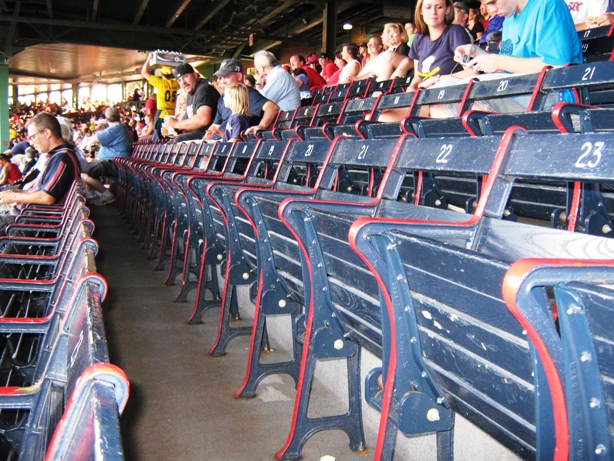
An atmosphere where everyone’s your amigo!
In A League Of Their Own, Tom Hanks has the perfect response to Geena Davis finally succumbing to how difficult the game of baseball is: “It’s supposed to be hard. If it wasn’t hard everyone would do it. The hard is what makes it great.”
This place isn’t for amateurs. Fenway Park is literally designed to weed out the casual fan. If you don’t love Red Sox baseball enough to endure that cramped, stiff seat with no view of right field, you don’t have to go. Not to worry. Someone will take your place…and that someone is exactly the kind of fan baseball needs more of anyway.
Why else on earth would fans tolerate extortionately priced tickets and parking, uncomfortable seats with blocked views, and far too many outfield seats in 2018? Why do Red Sox fans not only put up with all of this, but even sing collectively and enthusiastically about how good times never seemed so good?
Because Red Sox fans get baseball.
They get the incomparable thrill of investing their heart in a baseball team, and seeing a game winning hit bounce off of that green wall.
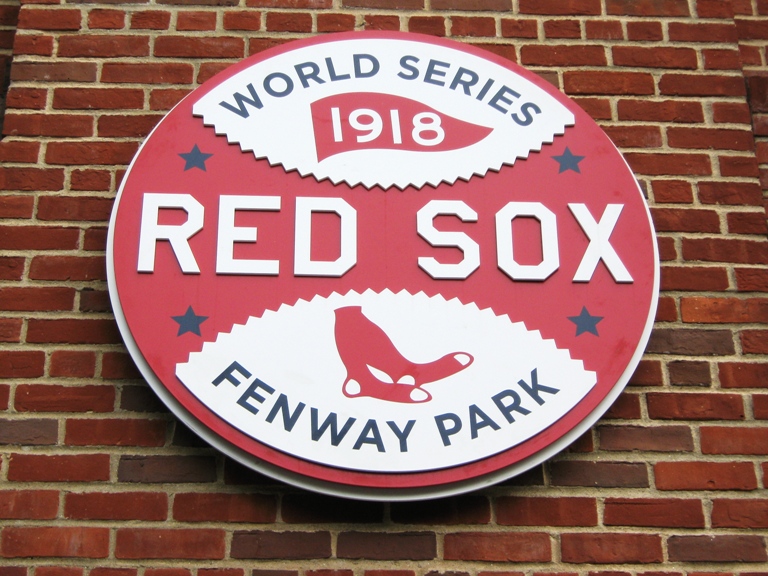
No problem, we’ll wait.
Maybe that simplifies it too much. Try this.
See if you can find someone who was there to witness Ted Williams’ 502-foot smash that landed in a seat now painted red to commemorate the occasion. Actually, that might be difficult, given that it happened in 1946. Maybe you’d have better luck finding someone who was in the ballpark when Carlton Fisk’s home run ball clanged off of the foul pole. That was only in 1975.
Still having trouble? Then try finding someone who was present when Big Papi’s game winner cleared the fence in the 12th, after journeyman first baseman Kevin Millar had duly warned everyone against allowing a Red Sox victory that night. That shouldn’t be impossible.
Found someone? Great. Ask them how much they paid for their ticket, or where they parked, or what the entertainment was between innings.
Chances are good the answers won’t be high on the list of what they remember most about the experience.
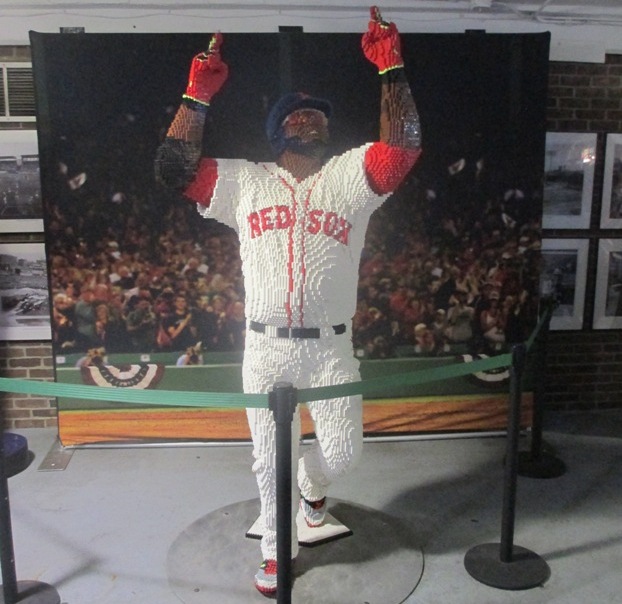
When they make a Lego figure of you, you’ve done ok.
Baseball’s history is a long, ongoing, and endlessly gripping page turner full of otherworldly moments. Nowhere is this more true than in Boston, from the devastating heartbreaks of an 86-year hex to the beyond spectacular glory of 2004. As Big Papi’s hit sailed over the fence and the Sox escaped the jaws of elimination, setting in motion the greatest comeback in sports history, no one in a partially obstructed seat that night would have traded the inconvenience to have missed it.
The Sox fans that overcame the considerable challenges to be inside Fenway Park on those fateful historic days considered it unquestionably worth the aggravation. Just as they continue to do by the millions every summer.
All the obstructions, expensive parking, crowded trains, and no great need for any ballgame sustenance other than a hot dog on mushy white bread. It all makes the point that no retractable roof, amenity-laden facility for baseball could ever make. For all of its flaws, because of its flaws, Fenway Park is absolutely everything a ballpark should be.
An eternal reminder that baseball, Red Sox baseball, is worth it.
Did this post make your day a little bit?
I hope so. If it did, I would really appreciate your support.
When you use this link to shop on Amazon, you’ll help subsidize this great website…at no extra charge to you.
Thanks very much…come back soon!
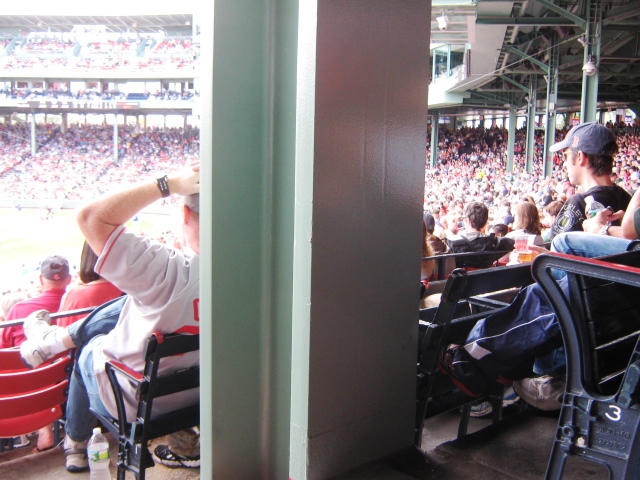
“Hey, I can’t see the guy in front of me!”
You CAN Avoid (Or At Least Minimize) The Obstructed View
Just because the support poles and their obstructed views keep out less dedicated fans doesn’t mean you have to endure them. There is actually a website called “Precise Seating” dedicated to providing the lowdown on every single seat in Fenway Park. It’s a fantastic resource for Sox fans.
With Precise Seating, you can put in all the information about a seat…section, row, and seat number…and the website will give the seat a 1-10 rating based on various factors: the view, distance from home plate and from the field, even shelter from rain. If there is an obstruction, the site will tell you what percentage of the field is blocked and whether you’ll be unable to see any of the bases or pitcher’s mound.
For example, say you’re looking at Grandstand Section 15, Row 5, Seat 1. Precise Seating will show you the obstruction, and how you won’t be able to see first or second base. They feature an actual photo from the seat, and being five rows from the pole it’s not too terribly bad, but if you have other choices you may want to look for another spot.
Precise Seating is a valuable tool, especially when searching around low numbered rows in the Grandstand. But if you don’t have access to it…say, when you’re patronizing a scalper…just remember a few things:
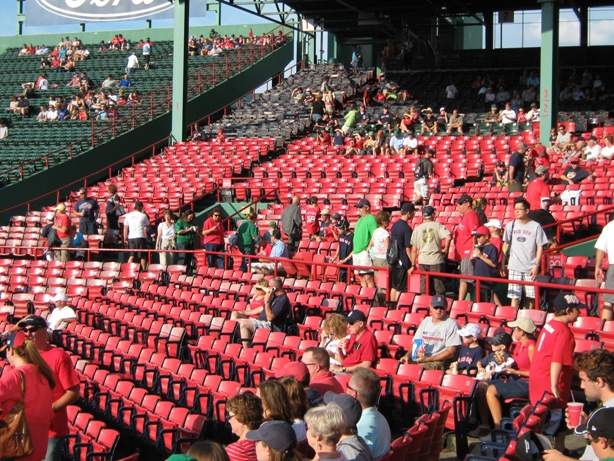
Or you could just sit in front of the poles.
Low rows in the Grandstand are the biggest risk, since the support pole is usually along the first or second row. If you’re going to try it, go for a seat number between 5-12, where you could not only be safe but you may land a great seat for the price. If you’re in a higher row, in most cases the obstruction isn’t too bad if you’re between seats 5-10.
Also, keep in mind that there are support poles in the high rows too, usually in Row 18 or 19. If you go for a seat this high, again, avoid low or high numbered seats. You won’t be able to see scoreboard this high up, incidentally, but there are TVs showing replays of the action.
One last thing: there are no support poles blocking views in Sections 19 and 21, on either side of home plate. Check those first!

A feast for the eyes at the ballpark. For less!
The Lansdowne Street Sausages
Part of the classic charm of Fenway Park is the sausage hawkers that surround the place…fans can get a decent sized tube of meat on a submarine roll for a few bucks less than what it would cost inside the park. You are indeed allowed to wrap them up and bring them into the game, if you can find some way to keep them warm while waiting in line.
Since most fans arrive at the ballpark from the Kenmore T station, the sausage vendors on Lansdowne Street are the most popular, being the first to emerge into view. They look similar, but there are differences between them. Here are a few fan favorites and what makes them special:
The Sausage Guy – Near the entrance to Cask ’N Flagon tavern is a small blue kiosk run by a gentleman named David Littlefield. The Sausage Guy’s website (yes, he has one) lists some of his stats: two frostbitten fingers from serving in the cold, a torn rotator cuff and three cortisone shots to his left elbow.
The Sausage Guy serves up good-sized sweet Italian sausage sandwiches with onions and peppers. It’s a pretty decent value and you can order the sausage on the website.
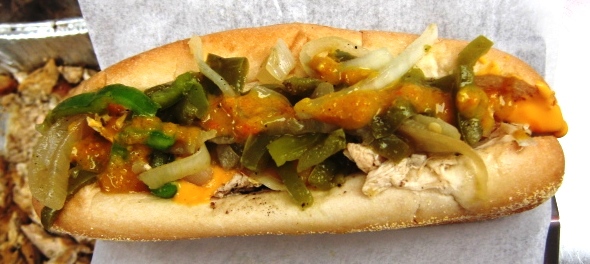
A chicken teriyaki from the Sausage Connection, with “Inner Beauty” hot sauce. Trust me on this one.
The Sausage Connection – The Sausage Connection is the yellow stand located near the Game Day ticket sales line. Not only do they serve up a mean sandwich of sausage, peppers and onions, they offer chicken teriyaki and steak tip sandwiches too.
What makes the Sausage Connection special in a sea of similar looking sausage vendors is their hot sauces, including the popular “Inner Beauty”, a tasty mustard-style sauce that will truly test your ability to handle the heat.
The Original Che-Chi’s – Che-Chi’s is the red stand further down on Lansdowne, and they have similar offerings like sausages, dogs and chicken. Che-Chi’s has their own secret hot sauce, which is a smoky BBQ-style sauce.
Che-Chi’s is also a tad more affordable than the rest; the sandwiches are a buck or two cheaper and they have soda specials.
Remember, you can bring them inside…

This is the easy part.
Alternate Transit Routes
Whether one drives to Fenway Park or uses the T, neither is a particularly pleasant method of transit. Driving to Fenway Park involves lengthy delays and hefty parking charges, but standing in a packed train car isn’t always the most fun ride either.
If you want to try something out of the ordinary, the excellent Fenway Park E-Guide offers some methods of transportation that you might not have considered and their merits:
Commuter Rail – On the Framingham/Worcester Line, Yawkey Station is just 500 feet from the ballpark, near Boston Beer Works. Parking lots this close often cost $50 and up. The ride is far less crowded, the seats are more plentiful and more comfortable, and the MBTA usually runs extra trains on game days.
The best part about this option is that you can book your parking at 100 Clarendon Street through the red Sox website very affordably, hop on the Commuter Rail from nearby Back Bay station, and go one inexpensive stop to the ballpark. Even with two or three people in the car, it’s still far cheaper than Fenway lot prices with just as much walking, and exiting from the garage is a snap afterwards.
Take The “E” Train – Most fans follow the advice on signs at stations that include transfers to the Green Line, the subway line that carries fans to Fenway: use any train except the “E”, which veers in another direction before stopping at Kenmore station.
This leaves the E trains far less crowded, and it’s not a total wash in getting to the ballpark: the Prudential and Symphony stations are maybe a 15-minute walk from Fenway. Many fans park at the Prudential garage to save a few dollars; using the E will spare you the Fenway crowds on the other trains.
And if you’re not up for that walk, you can hire someone to cycle you there in a rickshaw:
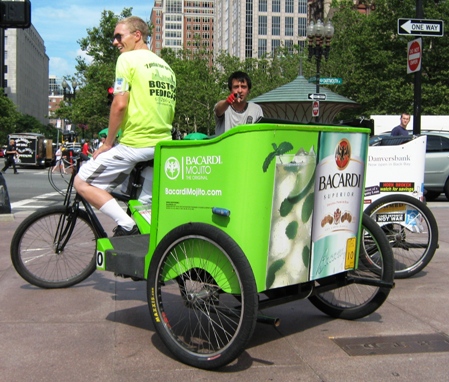
It’s obvious these guys are cool.
Boston Pedicab – The Boston Pedicab rickshaws can often be found around Fenway before and after games. You can find them all around downtown Boston too, especially at the Pru Center where people use them to ride to Sox games. They’re cyclists that pedal you to your destination for free; they subsist entirely on tips. Be generous. It’s a great way to avoid the traffic while enjoying a fine view of the city.
If you can’t find one, you can call Boston Pedicabs and they’ll send one out for you.
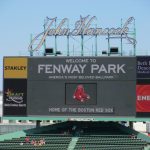
Great Gifts For Red Sox Fans + Fenway Visitors
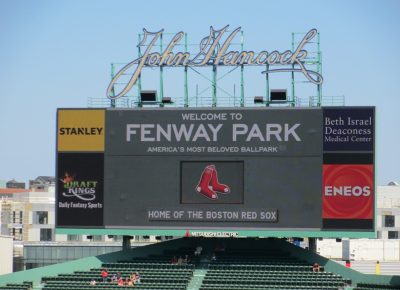
So you’ve got a Red Sox fan in your life, and you’re thinking about something that would make a super gift? As a ballpark guy, let me give you my best advice in gifts for Red Sox fans: give them something for their next game at Fenway.
Tickets obviously make a great gift, so here’s an excellent primer on how to find deals on Red Sox tickets for your loved one. But the Sox fan needs other equipment when visiting their favorite place on earth.
Stop paying ballpark prices for your Red Sox gear and souvenirs!
Order your essential Sox items before you go at Amazon.com, pay far less than you would at the game, AND get free shipping on orders over $25…order your Red Sox swag today!
Full disclosure: Ballpark E-Guides is an Amazon affiliate, so if you use these links to make a purchase, this website earns a commission at no extra cost to you. So you’re not just buying a super gift for a Red Sox fan, you’re helping baseball fans everywhere!
So thanks. Now then, Red Sox fans know about sitting in a chilly ballpark…

You did remember your leg warmers, right?
Gifts For Red Sox Fans, Part 1: Staying Warm at Fenway
Bundle up kids…Fenway Park can be a very cold place, especially in April…and October! So be sure that you look into some of these accessories as possible gifts:
This one is really really cool: sneaker slippers! I mentioned these in my gifts for Cubs fans post, but they’re made for Red Sox fans too: check these out here.
These footie slippers would look great on a lady Sox fan, and they’ll keep her feet comfortable and toasty on a cold game day.
There’s nothing like a knit cap to show your allegiance on a chilly evening at Fenway, and this particular edition is not only the nicest looking but also comes at the best price.
Amazon has a nice selection of hoodies and sweatshirts here…
(This one is my favorite, in case you’re thinking of getting one for me.)
And this sweater would be nice for the lady Sox fan in your life.
Scarves are underrated as necessary April/October baseball fan apparel at Fenway, and I think this decorated scarf makes a fantastic looking gift.
And a nice pair of gloves would go great with the scarf. (Are you starting to enjoy the image of your favorite Sox fan decked out like this?) This pair is Amazon’s choice and the price is great.
Finally, if you can manage to bring this fleece blanket into the ballpark on an April evening, you’ll be very glad.

Save the Red Sox fan in your life a trip to this more expensive spot.
Gifts For Red Sox Fans, Part 2: Essential Game Day Apparel
You’ll need a cap at a Red Sox game of course, and they’re much cheaper on Amazon than they’ll be at the ballpark (and that may even include the outside vendors). Here is their selection, including a cool green St. Patty’s Day cap.
As far as caps go, I prefer the red cap to the dark blue one, and this is likely a better deal than you’ll find inside the ballpark.
As I’ve stated on the Cubs fan gift post, there’s a much better selection of jerseys in the MLBShop.com store (maybe I should become an affiliate), but if you can find something on Amazon, it will probably be cheaper.

Now you know what to get for lady Sox fans.
There is a very cool selection of Red Sox earrings on Amazon…a great gift for the lady Sox fan. (or hey, a progressive guy Sox fan). Check out this pair, or this pair…they’re both great.
And what goes better with Red Sox earrings than a decorated bow? This one is surprisingly affordable…and you’re working it now, buddy.
You can find some really cool tees here (I even checked the free shipping box for you)…
But this one is amazing looking, and I say this as someone who’s not a big tie-dye or Grateful Dead fan.
Then there’s the Citgo logo tee, the reason for which is obvious to any Fenway dweller.
And of course, your tiny young new Red Sox fan needs to show his colors early.
As far as fandom and showing allegiance, do you want to be one of those really weird fans that stands out even in a Red Sox-apparel adorned crowd? Then this suit is for you…go for it! (I’m not sure I would give it as a gift though.)

Note the virtually complete absence of shade.
Gifts For Red Sox Fans, Part 3: Necessary Fenway Accessories
If the Red Sox fan in your life is going to Fenway and is planning to sit in the bleachers, listen up…they are going to need sunglasses! Take it from this Fenway Park expert…
Here’s a very cool pair of Red Sox branded sun frames for those bright bleacher afternoons.
Other essential Fenway visitor items include cooler bags, because as you may know, you can bring your own food and non-alcoholic drinks into Fenway. (Read more about that here.)
Seriously, share this knowledge when you hand the Red Sox fan in your life their Red Sox cooler bag.

Wrap up this beauty of a chicken teriyaki sandwich and sneak it into the ballpark!
You can easily fit your sandwich from the Sausage Connection into this thing…
And this cooler bag will just as easily store your sodas and bottled waters (and it’s cheaper).
Obstructed views aren’t the only problem with Fenway’s Grandstand seats. They’re also small and hard to sit on. A Red Sox seat cushion makes a great gift for anyone who likes the Grandstand seating.
If you’re out in the bleachers, or in the Green Monster seats, you’ll want to be prepared if the rains come. Check out this ultra-cool umbrella.
If you’re paying the considerable price for a beer at Fenway, keep it cold. This.

Membership includes a Red Sox fanny pack!
Gifts For Red Sox Fans, Part 4: Car Décor, Books, and the Best Yankee Hater Gift of All
If the Red Sox fan in your life is driving to the game, at least help him or her decorate the car accordingly, with championship accessories…here’s a particularly nice license plate holder, and here’s a car flag…two excellent and affordable stocking stuffers!
OK, maybe it’s not Fenway necessary gear, but while your lucky gift recipient is waiting for the baseball season, they will need some Red Sox reading material.
I confess to not having read all of these, but they are recommended in posts that I’ve read…
This is a best seller from the very popular Jerry Remy, currently a Red Sox broadcaster. I would check somehow and make sure your Red Sox fan doesn’t have it…you can’t go wrong with a Jerry Remy book for a Sox fan.
Stewart O’Nan is a terrific writer, and I don’t need to tell you who Stephen King is. They decided to chronicle an entire season of Red Sox baseball together. In 2004. Again, check and make sure your fan doesn’t already own this one…

Yes, this man is this beloved in this town.
Here’s another subject that’s always a winner with Red Sox fans.
Finally, I had to include this book just for the title. It’s almost worth the price for a Red Sox fan just to have it on display in your home.
And while I don’t know if you can buy it anymore, what Red Sox fan wouldn’t want to use this?
There you go my friend…some fantastic and useful gifts for Red Sox fans, especially for their next trip to see the Sox at baseball’s most historic and storied ballpark.
Speaking of, be sure to get the Red Sox fan in your life to check out some great Fenway Park tips…have them start here!

